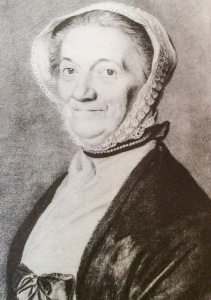 Elizabeth Postlethwaite in 1777
Elizabeth Postlethwaite in 1777(© Copyright National Portrait Gallery, London)
A little while ago, rummaging in a secondhand bookshop as I often do, I found a small, locally-published book containing extracts from the correspondence of two Norfolk sisters, Elizabeth and Barbara, during the period 1733 to 1751.[1]
They were the daughters of Rev. Mathew Postlethwaite and Elizabeth Rogerson and had been born at the Rectory at Denton, south of Norwich in the direction of Bungay and the Suffolk border. When their mother died in 1730, their father married again, this time to Matilda Gooch[2]. At age 19, Barbara married a clergyman called Samuel Kerrich, vicar of Dersingham near the present Royal Family’s estate at Sandringham on the northwest of the county.
What to us would be a trivial, if probably slow journey of some 40 miles between the two locations proved an almost insuperable distance to these devoted sisters. Both, it seems, were rarely in a state of health good enough to face the rigours of country roads in the 1740s. Barbara was frequently pregnant and suffered several miscarriages; Elizabeth had some unspecified complaint that caused her to cough and experience feelings of great weakness and lassitude.
In these respects, it is probably fair to say that the two were not untypical of mid-eighteenth-century women of the middling sort. It’s easy to dismiss them as suffering mostly from hypochondria. Yet their letters show just how omnipresent death was amongst their families and friends, and how swiftly what began as a minor ailment developed into something far more life-threatening.
‘Official’ Remedies
We would expect them to share information on their states of health, especially during the long periods when they did not meet. They did this frequently and at length. However, what is of greater interest is the advice they exchanged on remedies; advice more likely to come from their friends and acquaintances than any qualified medical professional.
Medical professionals were not excluded entirely, though their advice may sometimes have done more harm than good. Writing to Barbara on 9th August, 1733, Elisabeth remarks that her father had chanced to meet the eminent Norwich physician Sir Benjamin Wrench at the dean’s house. Elisabeth’s constant problems were obviously part of the conversation, for she remarks that Sir Benjamin “… have [sic] thought of something that he is in hopes will be of great service to me.”
Exactly what that was is unclear, but Barbara writes on 29th October of the same year that she is glad Elizabeth has “done with the mercury”. Then she goes on:
… everybody that I have heard speak of it, say it is very lucky for them that take it if they find no hurt from it …”
She goes on to relate part of a humorous article on mercury as medicine for women she found “… in the magazine for August…”, to the effect that the only good it could do would be to “… turn ’em into barometers, that they may know whether it will be proper to go a visiting and when to be in bed …”
Elizabeth also writes from time to time of “being blooded” and “having a blister”, the result of cupping. Neither seem to do her any good, which is hardly surprising.
Home-made Remedies
In August, 1738, Elizabeth sends her sister a ‘Receipt’ for strengthening the blood, which she says she has got from Mrs Townshend:
Take three handfuls of red sage, stamp it in a stone mortar very small, put it into a quart of red port and let it stand 3 or 4 days close covered, then strain it out and bottle it. Take three spoonfuls of it and four spoonfuls of running water in a morning, fasting until the [port[3]]be done. This is good for scurvy and spleen.
In September, 1745, Elizabeth writes that their mother is unwell: “… her stomach [appetite?] is quite gone, that it was a punishment to her to get anything down.” As a result:
She is trying chocolate in a morning and take some mutton broth in an afternoon, for she thinks kitchen physic is best for her.
This didn’t seem to do much good, for Elizabeth returns to her mother’s illness in a letter dated 26th December, 1745:
… she tell me she have quite lost her stomach again, her constitution is quite broke. I doubt, I am afraid, she will never [sic] have her health again[4].
Barbara also took patent remedies for her health, for Elizabeth writes to her on 4th February, 1747:
I am glad you are got well and that you intend to try tar water,[5] I hope that it will keep you so.
Barbara did not reply on this point until March, 1748, when she wrote:
I drank tar water about a week, I like it mighty well, it was very agreeable to my stomach, but my bowels have never been right since that disorder in them. … I have been forced to take tincture of rhubarb twice or thrice o’week, but when my bowels are more settled I shall try it again.
Barbara’s husband was also sick in October, 1747, almost certainly with the malaria that spread easily near to the Fen Country of those parts. She writes:
The Dr[6] have had three fits of a tertian ague and expected another fit last Saturday evening … he have taken the bark[7] 3 or 4 times everyday since that he have had no more of it and he look very well …
“My Ailment is Breeding … ”
It is not be surprising to find that the married sister, Barbara, sometimes seems angry at the strain constant pregnancies places upon her. You need to read between the lines a little here, but it looks as if she may be hoping to rid herself of yet another child[8]. She writes in July, 1748:
Ever since I wrote to you last I have been very poorly, so faint o’mornings I am forced to rest 2 or 3 times before I can get my things on. I drink chocolate every morning and have been blooded, for I find my ailment is breeding. … I wonder I haven’t miscarried yet …
From the rest of the letter it is clear that she has been taking pennyroyal water. This was often used as a purgative and was said to be effective at expelling a dead child from the womb. Her sister Elizabeth was obviously worried, for she replied almost right away that, “… I beg you would be very careful of yourself and prevent if possible miscarrying, you know it is a very great injury, and weakening to your constitution.”[9]
By December, 1748, Barbara’s time is near and we find Elizabeth urging her to be sure to engage the services of a man-midwife. In January, Barbara took to her bed, still feeling ill, but believing the child “alive and well at present”. She was delivered of a boy in February, the only son who would survive the terrors of infancy.
In 1751, the sisters were reunited in Dersingham. Their father had died in 1745, but the household continued at Denton for a period, while their brother tried to persuade the owners of the advowson to allow him to succeed his father in the living. He was unsuccessful and eventually they all moved out. The brother received another living as a consolation prize, the sisters’ step-mother moved to Benacre, and Elizabeth moved to be with her sister again.
Despite her constant ill-health, Elizabeth proved to be much the stronger of the two, living until 1794 and surviving her sister by no less than 32 years.
Elizabeth Postlethwaite in 1777 (© Copyright National Portrait Gallery, London)
- Your affectionate and loving sister: the correspondence of Barbara Kerrich and Elizabeth Postlethwaite, 1733 to 1751, Nigel Surry (ed.), Larks Press, Dereham, 2000.` ↩
- She is the ‘mother’ referred to in the correspondence. She was sister to the Bishop of Norwich of the period. ↩
- The original says ‘claret’, but port must be meant. ↩
- She lived until 1760. ↩
- A foul-tasting remedy for colic made from pine tar and water, popularised by Bishop Berkeley at the start of the century. ↩
- She always calls him thus. He was a Doctor of Divinity. ↩
- The bark of the cinchona tree, the source of quinine. ↩
- With all the problems she had and the many childhood illnesses, only two of her children survived infancy to grow up. ↩
- Barbara did not miscarry, but her illness persisted throughout July, August and September. Elizabeth kept urging her to take “Mrs Townshend’s remedy” [mentioned above. ↩



There were several stories printed about tar water cures in the Gentleman’s Magazine of 1745. Being pine tar, it probably did help more than a few people. Certainly it would have been one thing likely to do no harm, especially when applied externally for skin complaints.
Thanks for sharing this: it was fascinating, and I never before heard the term “kitchen physic.”
LikeLiked by 1 person
Thanks for your helpful and informative comment.
LikeLike
I’d be interested to know if any of the herbal remedies helped. I’m even more intrigued by Barbara’s attitude to her pregnancy. There’s a sad story there, as you’ve detected.
LikeLiked by 1 person
I think some must have done — at least much more than anything else in use at the same time.
LikeLike